
Asterales is an order of dicotyledonous flowering plants that includes the large family Asteraceae known for composite flowers made of florets, and ten families related to the Asteraceae. While asterids in general are characterized by fused petals, composite flowers consisting of many florets create the false appearance of separate petals.

Senecio is a genus of flowering plants in the daisy family (Asteraceae) that includes ragworts and groundsels.

Cynara is a genus of thistle-like perennial plants in the family Asteraceae. They are native to the Mediterranean region, the Middle East, northwestern Africa, and the Canary Islands. The genus name comes from the Greek kynara, which means "artichoke".
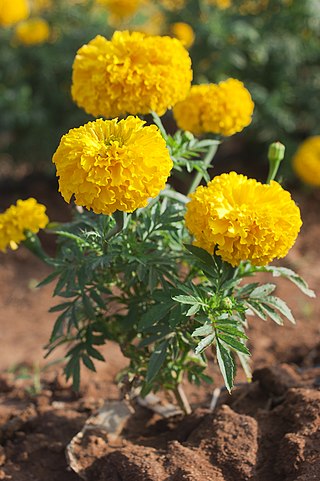
Tagetes is a genus of 50 species of annual or perennial, mostly herbaceous plants in the family Asteraceae. They are among several groups of plants known in English as marigolds. The genus Tagetes was described by Carl Linnaeus in 1753.

Osteospermum, is a genus of flowering plants belonging to the Calenduleae, one of the smaller tribes of the sunflower/daisy family Asteraceae. They are known as the daisybushes or African daisies. Its species have been given several common names, including African daisy, South African daisy, Cape daisy and blue-eyed daisy.
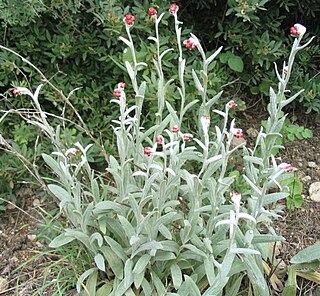
The genus Helichrysum consists of an estimated 600 species of flowering plants in the sunflower family (Asteraceae). The type species is Helichrysum orientale. They often go by the names everlasting, immortelle, and strawflower. The name is derived from the Ancient Greek words ἥλιος and χρῡσός.

The family Campanulaceae, of the order Asterales, contains nearly 2400 species in 84 genera of herbaceous plants, shrubs, and rarely small trees, often with milky sap. Among them are several familiar garden plants belonging to the genera Campanula (bellflower), Lobelia, and Platycodon (balloonflower). Campanula rapunculus and Codonopsis lanceolata are eaten as vegetables. Lobelia inflata, L. siphilitica and L. tupa and others have been used as medicinal plants. Campanula rapunculoides may be a troublesome weed, particularly in gardens, while Legousia spp. may occur in arable fields.
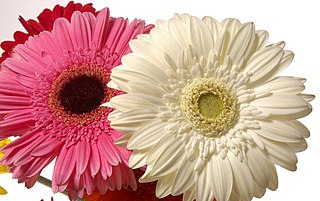
Gerbera L. is a genus of plants in the Asteraceae (Compositae) family. The first scientific description of a Gerbera was made by J. D. Hooker in Curtis's Botanical Magazine in 1889 when he described Gerbera jamesonii, a South African species also known as Transvaal daisy or Barberton daisy. Gerbera is also commonly known as the African daisy.
Harold Ernest Robinson was an American botanist and entomologist.

Osteospermum moniliferum is an evergreen flowering shrub or small tree in the daisy family, Asteraceae. It is native to southern Africa, ranging through South Africa and Lesotho to Mozambique and Zimbabwe.

Gazania is a genus of flowering plants in the family Asteraceae, native to Southern Africa.
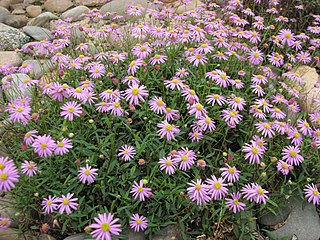
Brachyscome is a genus of flowering plants in the family Asteraceae. Most are endemic to Australia, and a few occur in New Zealand and New Guinea.

Calenduleae is a flowering plant tribe of the family Asteraceae. Calenduleae has been widely recognized since Alexandre de Cassini in the early 19th century. There are eight genera and over 110 species, mostly found in South Africa.

Layia is a genus of flowering plants in the family Asteraceae known generally as tidy tips, native to western North America. Several are California endemics.
Myriactis is a genus of flowering plants in the tribe Astereae within the family Asteraceae.
Printzia is a genus of South African plants in the tribe Astereae within the family Asteraceae.
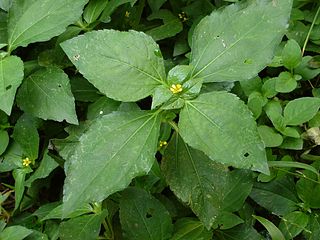
Synedrella is a genus of flowering plants in the family Asteraceae.
Platycarpha is a genus of South African plants within the family Asteraceae.

Metalasia muricata, commonly known as white bristle bush or blombos, is a hardy virgate or twiggy shrub with honey-scented flowers usually 2–4 m tall, woody with a rounded crown. It is native to the Cape Provinces of South Africa, where it is an important component of the coastal and mountain fynbos regions. It is encountered in a number of forms in its extended distribution, some of which are tolerant of frost, wind and poor sandy soils.
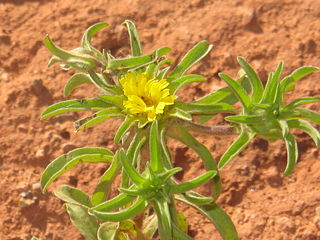
Asteriscus aquaticus is a species of flowering plant. The flower is part of the so-called "Asteriscus alliance".
















